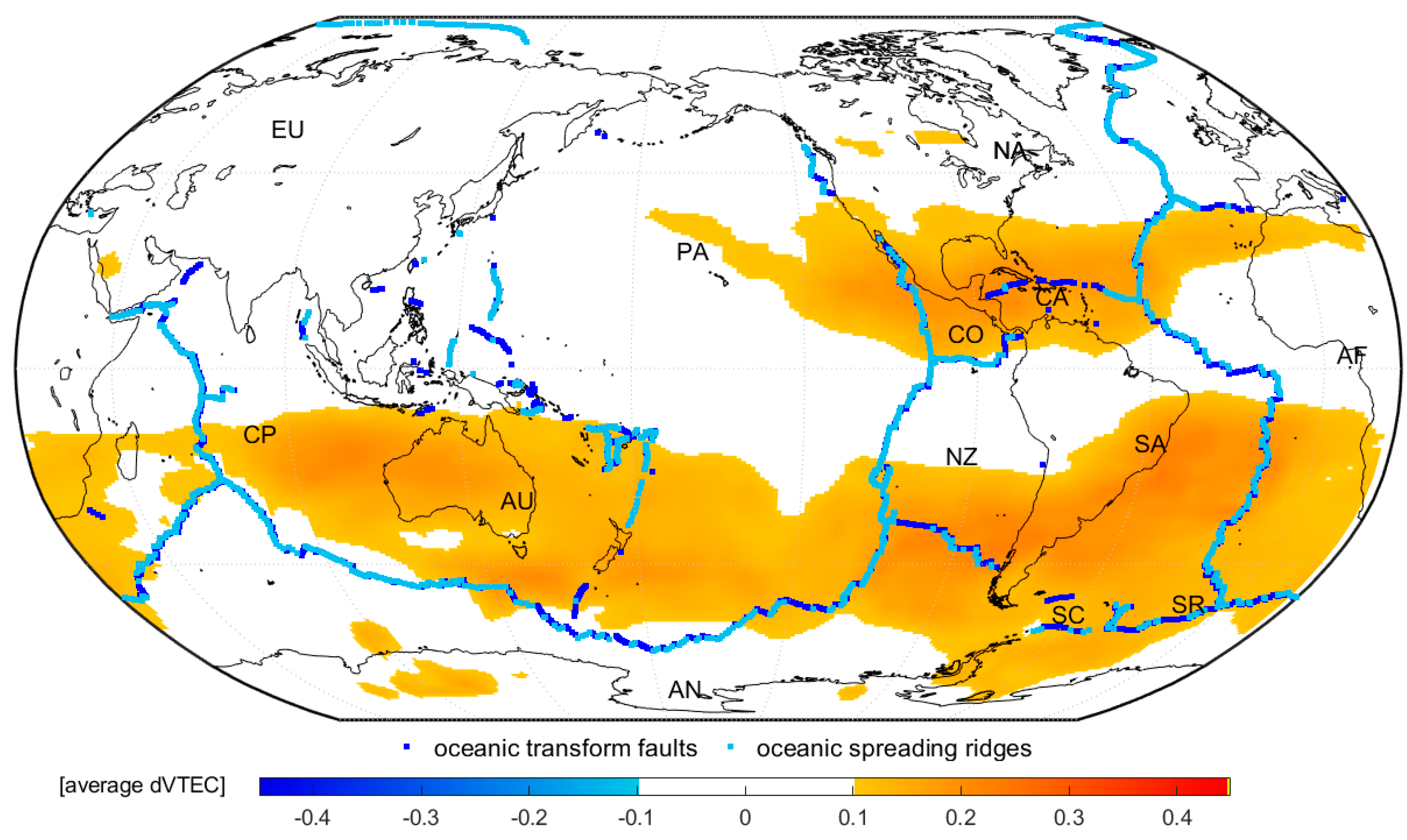Vertical Total Electron Content Enhancements and Their Global Distribution in Relation to Tectonic Plate Boundaries
Abstract
1. Introduction
1.1. Total Electron Content Variations Activated by Internal and External Sources
1.2. Global Ionosphere Maps in Studies of TEC Enhancements and Depletions
1.3. TEC Variations During Geomagnetic Storms in Comparison to Seismically Driven TEC Enhancements
1.4. Probable LAIC Models of TEC Enhancement Related to Seismicity
2. Data and Methods
3. Results: VTEC Anomalies (dVTEC) Lasting Hours over Tectonic Plate Boundaries
3.1. VTEC Enhancements and Depletions During Low Geomagnetic Activity
3.2. VTEC Enhancements and Depletions During Strong Geomagnetic Activity
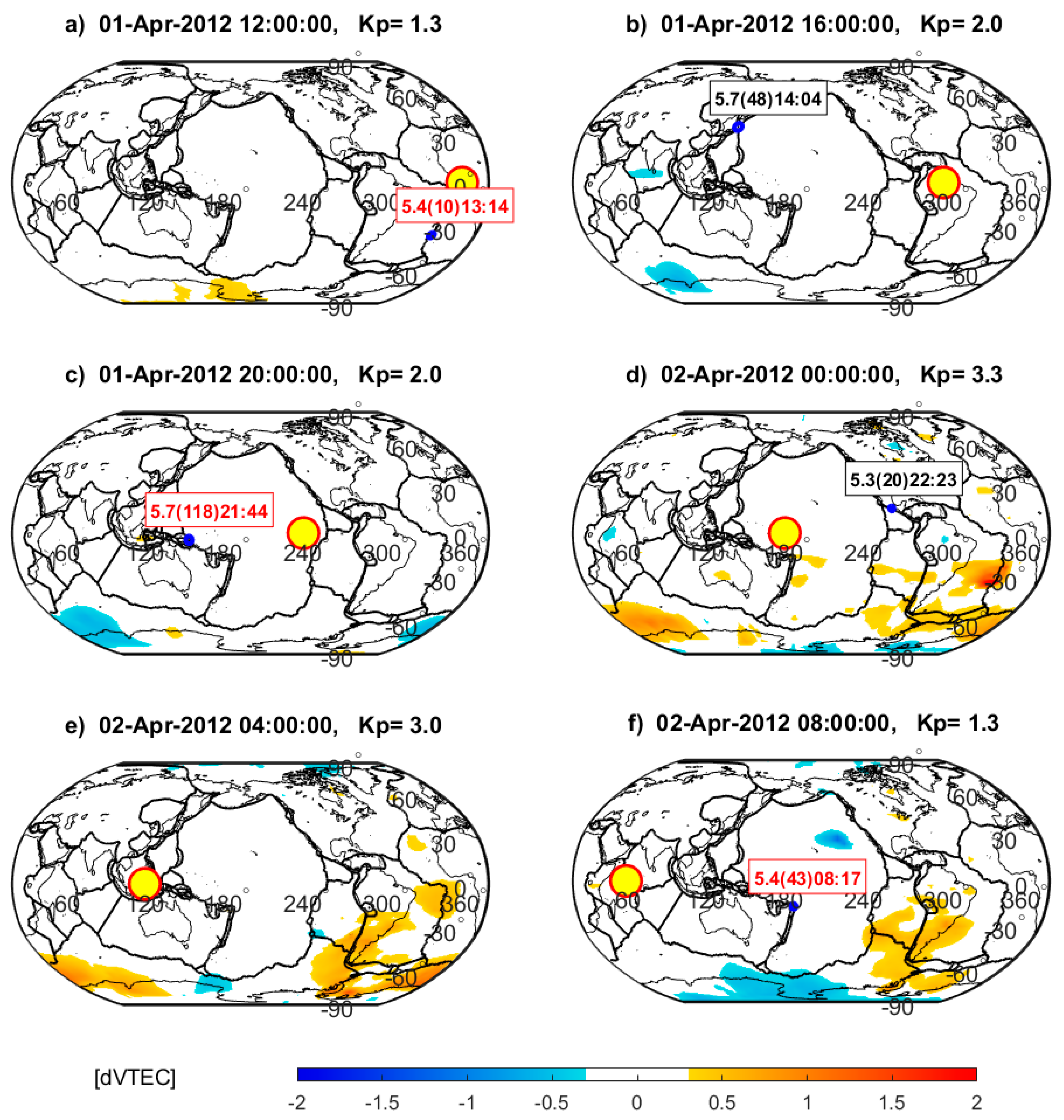
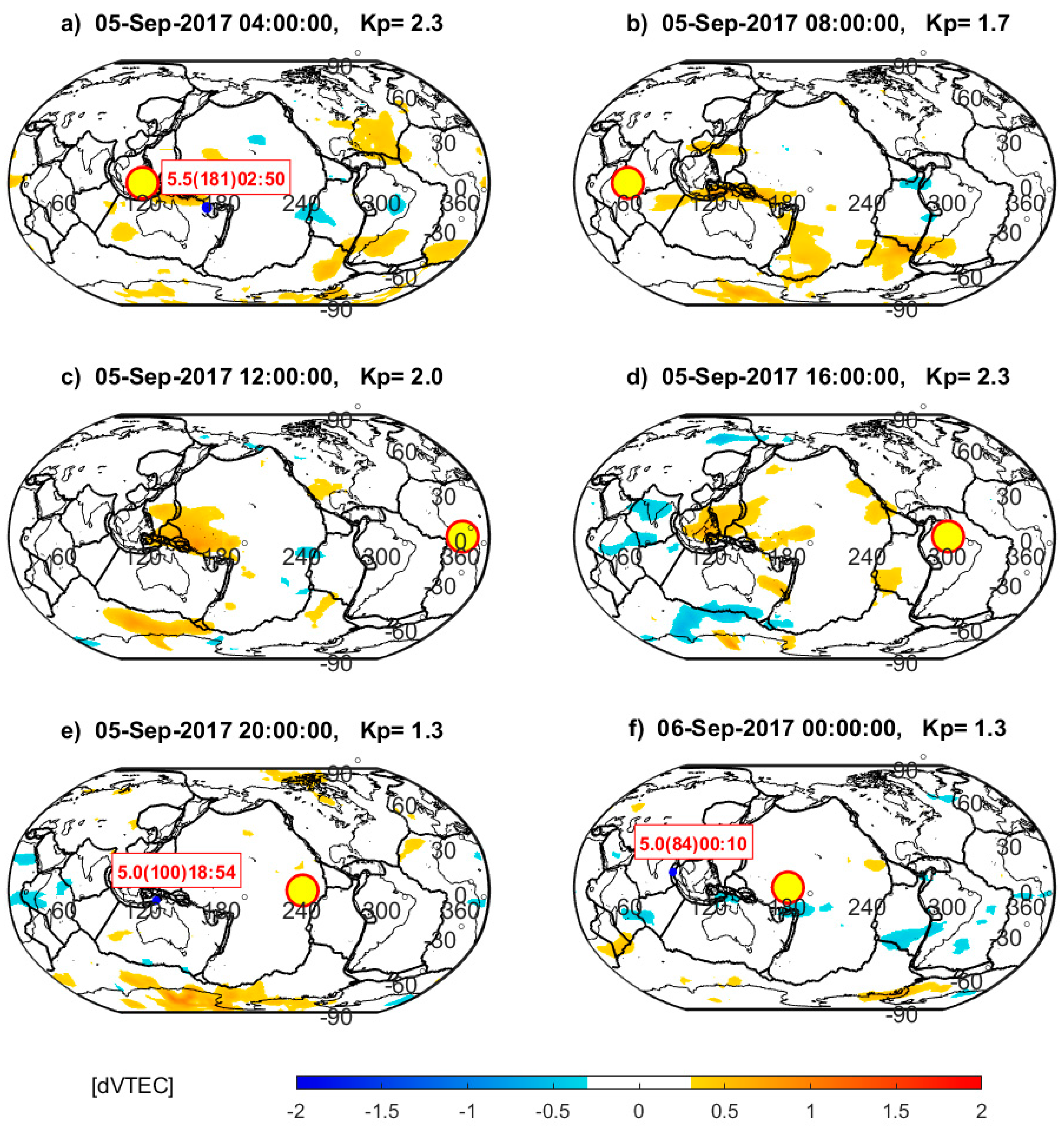
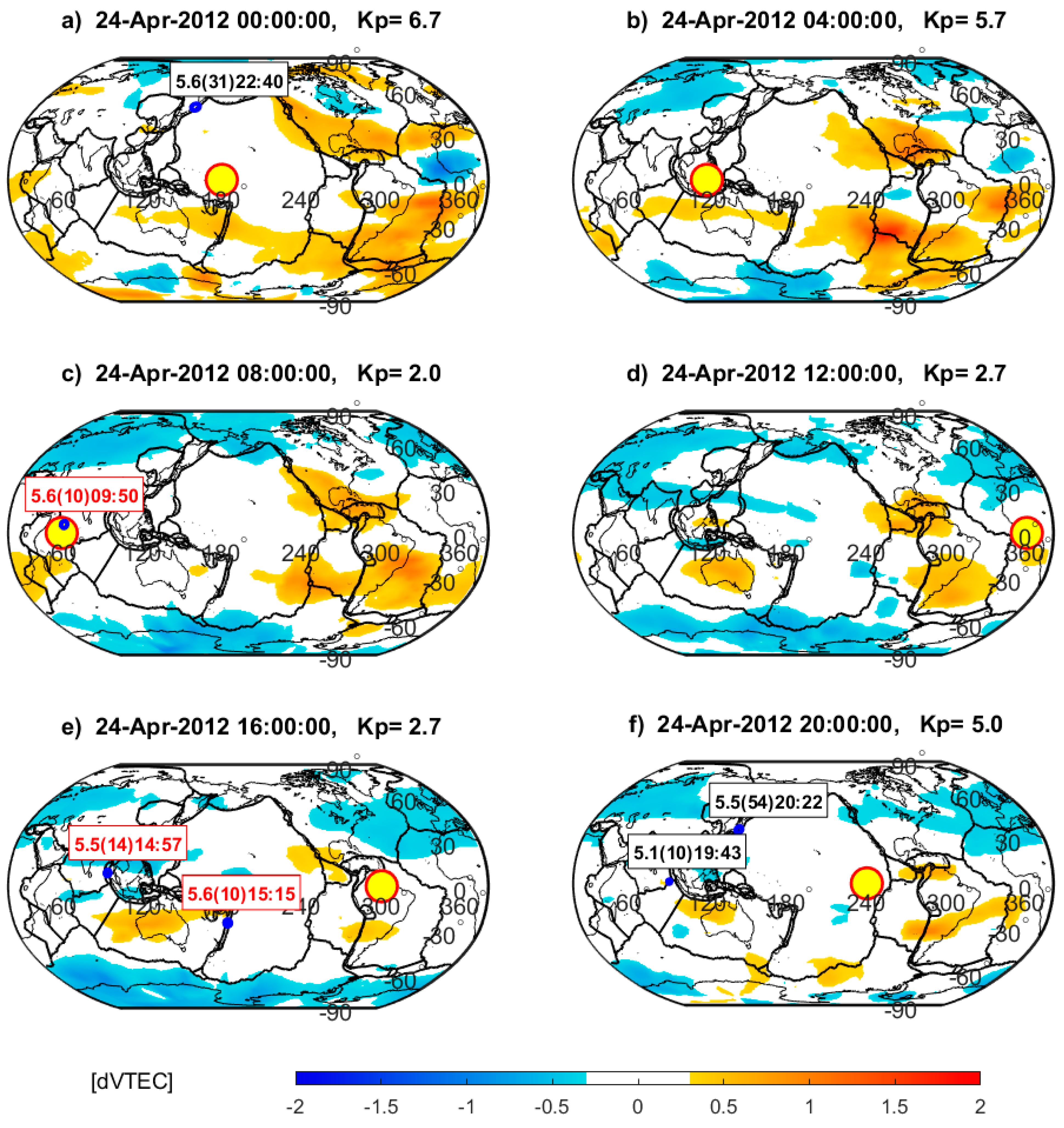
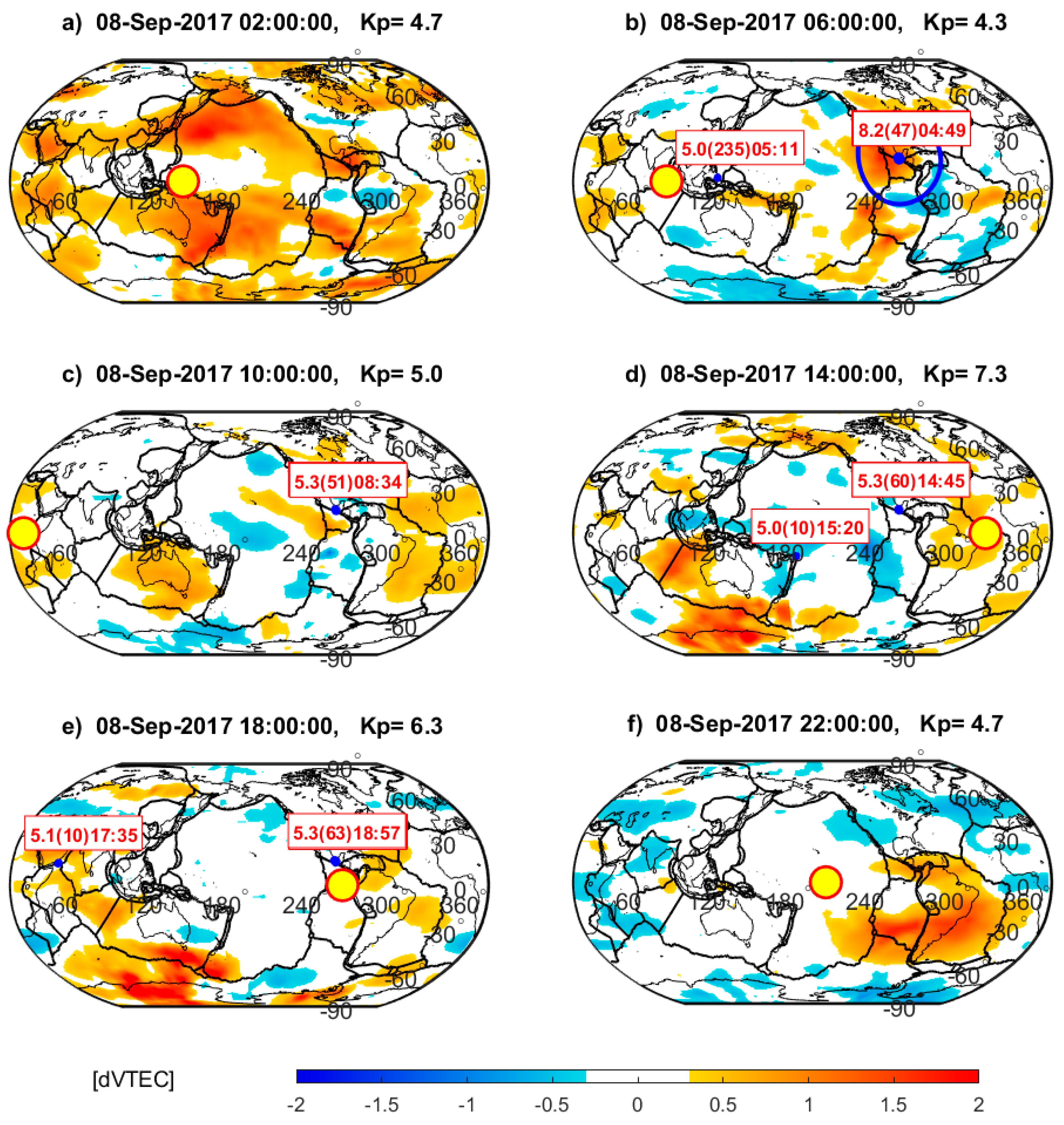
3.3. VTEC Enhancements Without M ≥ 5.0 Earthquakes Exhibiting Shapes of Tectonic Plate Boundaries
4. Discussion: Statistical Assessment of the Most Frequent Geographical Location of VTEC Enhancements and Links with Existing Studies of Other Kinds
5. Conclusions
Author Contributions
Funding
Data Availability Statement
Acknowledgments
Conflicts of Interest
Abbreviations
| AGW | acoustic gravity wave |
| CODE | Centre for Orbit Determination in Europe |
| CRB | continental rift boundary |
| CTF | continental transform fault |
| EFM | electric field modification |
| EIA | equatorial ionization anomaly |
| EM | electromagnetic |
| GIM | global ionospheric map |
| GNSS | global navigation satellite system |
| LAIC | lithosphere–atmosphere–ionosphere coupling |
| MSNA | Midlatitude Summer Nighttime Anomaly |
| OSR | oceanic spreading ridge |
| OTF | oceanic transform fault |
| STEC | slant total electron content |
| SUB | subducting boundary |
| TEC | total electron content |
| UQRG | UPC-IonSAT quarter-of-an-hour time resolution rapid global ionospheric map |
| UPC | Polytechnic University of Catalonia |
| UTC | universal time coordinated |
| VTEC | vertical total electron content |
| Abbreviations of tectonic plates | |
| AF | African (tectonic plate) |
| AN | Antarctic |
| AR | Arabic |
| AU | Australian |
| CA | Caribbean |
| CO | Coco |
| CP | Capricorn |
| EU | Eurasian |
| IN | Indian |
| NA | North American |
| NZ | Nazca |
| OK | Okhotsk |
| PA | Pacific |
| SA | South American |
| SC | Scotia |
| SM | Somalian |
| SU | Sunda |
References
- Mannucci, A.; Wilson, B.; Yuan, D.; Ho, C.; Lindqwister, U.; Runge, T. A global mapping technique for GPS-derived ionospheric total electron content measurements. Radio Sci. 1998, 33, 565–582. [Google Scholar] [CrossRef]
- Pulinets, S.; Boyarchuk, K. Ionospheric Precursors of Earthquakes; Springer: Berlin/Heidelberg, Germany, 2005; 315p. [Google Scholar] [CrossRef]
- Bychkov, V.; Golubkov, G.; Nikitin, A. The Atmosphere and Ionosphere; Springer Science+Business Media B.V.: Dordrecht, The Netherlands, 2013; 288p. [Google Scholar] [CrossRef]
- Jin, S.; Jin, R.; Liu, X. GNSS Atmospheric Seismology: Theory, Observations and Modeling; Springer: Singapore, 2019; 315p. [Google Scholar] [CrossRef]
- Hayakawa, M.; Izutsu, J.; Schekotov, A.; Yang, S.-S.; Solovieva, M.; Budilova, E. Lithosphere–Atmosphere–Ionosphere Coupling Effects Based on Multiparameter Precursor Observations for February–March 2021 Earthquakes (M~7) in the Offshore of Tohoku Area of Japan. Geosciences 2021, 11, 481. [Google Scholar] [CrossRef]
- Urias, C.L.; Vazquez-Becerra, G.E.; Nayak, K.; López-Montes, R. Analysis of Ionospheric Disturbances during X-Class Solar Flares (2021–2022) Using GNSS Data and Wavelet Analysis. Remote Sens. 2023, 15, 4626. [Google Scholar] [CrossRef]
- Tariq, M.A.; Shah, M.; Hernández-Pajares, M.; Iqbal, T. Pre-earthquake ionospheric anomalies before three major earthquakes by GPS-TEC and GIM-TEC data during 2015–2017. Adv. Space Res. 2019, 63, 2088–2099. [Google Scholar] [CrossRef]
- Ghimire, B.D.; Chapagain, N.P. Ionospheric Anomalies Due to Nepal Earthquake-2015 as Observed from GPS-TEC Data. Geomagn. Aeron. 2022, 62, 460–473. [Google Scholar] [CrossRef]
- Nayak, K.; Romero-Andrade, R.; Sharma, G.; Zavala, J.L.C.; Urias, C.L.; Soto, M.E.T.; Aggarwal, S.P. A combined approach using b-value and ionospheric GPS-TEC for large earthquake precursor detection: A case study for the Colima earthquake of 7.7 Mw, Mexico. Acta Geod. Geophys. 2023, 58, 515–538. [Google Scholar] [CrossRef]
- Sharma, G.; Nayak, K.; Romero-Andrade, R.; Mohammed Aslam, M.A.; Sarma, K.K.; Aggarwal, S.P. Low Ionosphere Density Above the Earthquake Epicentre Region of Mw 7.2, El Mayor–Cucapah Earthquake Evident from Dense CORS Data. J. Indian. Soc. Remote Sens. 2024, 52, 543–555. [Google Scholar] [CrossRef]
- Occhipinti, G.; Rolland, L.; Lognonné, P.; Watada, S. From Sumatra 2004 to Tohoku-Oki 2011: The systematic GPS detection of the ionospheric signature induced by tsunamigenic earthquakes. J. Geophys. Res. Space Phys. 2013, 118, 3626–3636. [Google Scholar] [CrossRef]
- Chou, M.-Y.; Cherniak, I.; Lin, C.C.H.; Pedatella, N.M. The persistent ionospheric responses over Japan after the impact of the 2011 Tohoku earthquake. Space Weather 2020, 18, e2019SW002302. [Google Scholar] [CrossRef]
- Jin, S.G.; Jin, R.; Li, J.H. Pattern and evolution of seismo-ionospheric disturbances following the 2011 Tohoku earthquakes from GPS observations. J. Geophys. Res. Space Phys. 2014, 119, 7914–7927. [Google Scholar] [CrossRef]
- Jarmołowski, W.; Belehaki, A.; Hernández Pajares, M.; Schmidt, M.; Goss, A.; Wielgosz, P.; Yang, H.; Krypiak-Gregorczyk, A.; Tsagouri, I.; Paouris, E.; et al. Combining Swarm Langmuir probe observations, LEO-POD-based and ground-based GNSS receivers and ionosondes for prompt detection of ionospheric earthquake and tsunami signatures: Case study of 2015 Chile-Illapel event. J. Space Weather Space Clim. 2021, 11, 58. [Google Scholar] [CrossRef]
- Urata, N.; Duma, G.; Freund, F. Geomagnetic Kp Index and Earthquakes. Open J. Earthq. Res. 2018, 7, 39–52. [Google Scholar] [CrossRef]
- Enomoto, Y.; Heki, K.; Yamabe, T.; Sugiura, S.; Kondo, H. A Possible Causal Mechanism of Geomagnetic Variations as Observed Immediately before and after the 2011 Tohoku-Oki Earthquake. Open J. Earthq. Res. 2020, 9, 33–49. [Google Scholar] [CrossRef][Green Version]
- Chakraborty, M.; Kumar, S.; De, B.K.; Guha, A. Effects of geomagnetic storm on low latitude ionospheric total electron content: A case study from Indian sector. J. Earth Syst. Sci. 2015, 124, 1115–1126. [Google Scholar] [CrossRef]
- Arikan, F.; Yarici, A. Spectral investigation of traveling ionospheric disturbances: IONOLAB-FFT. Geod. Geodyn. 2017, 8, 297–304. [Google Scholar] [CrossRef]
- Choi, B.K.; Lee, S.J.; Park, J.U. Monitoring the ionospheric total electron content variations over the Korean Peninsula using a GPS network during geomagnetic storms. Earth Planets Space 2011, 63, 469–476. [Google Scholar] [CrossRef]
- Shim, J.S.; Tsagouri, I.; Goncharenko, L.; Rastaetter, L.; Kuznetsova, M.; Bilitza, D.; Codrescu, M.; Coster, A.J.; Solomon, S.C.; Fedrizzi, M.; et al. Validation of ionospheric specifications during geomagnetic storms: TEC and foF2 during the 2013 March storm event. Space Weather 2018, 16, 1686–1701. [Google Scholar] [CrossRef]
- Heki, K. Ionospheric electron enhancement preceding the 2011 Tohoku-Oki earthquake. Geophys. Res. Lett. 2011, 38, L17312. [Google Scholar] [CrossRef]
- Heki, K.; Enomoto, Y. Preseismic ionospheric electron enhancements revisited. J. Geophys. Res. Space Phys. 2013, 118, 6618–6626. [Google Scholar] [CrossRef]
- Kamogawa, M.; Kakinami, Y. Is an ionospheric electron enhancement preceding the 2011 Tohoku-Oki earthquake a precursor? J. Geophys. Res. Space Phys. 2013, 118, 1751–1754. [Google Scholar] [CrossRef]
- Ikuta, R.; Hisada, T.; Karakama, G.; Kuwano, O. Stochastic evaluation of pre-earthquake TEC enhancements. J. Geophys. Res. Space Phys. 2020, 125, e2020JA027899. [Google Scholar] [CrossRef]
- Nayak, K.; Romero-Andrade, R.; Sharma, G.; López-Urías, C.; Trejo-Soto, M.E.; Vidal-Vega, A.I. Evaluating Ionospheric Total Electron Content (TEC) Variations as Precursors to Seismic Activity: Insights from the 2024 Noto Peninsula and Nichinan Earthquakes of Japan. Atmosphere 2024, 15, 1492. [Google Scholar] [CrossRef]
- He, L.; Heki, K. Threedimensional distribution of ionospheric anomalies prior to three large earthquakes in Chile. Geophys. Res. Lett. 2016, 43, 7287–7293. [Google Scholar] [CrossRef]
- Oikonomou, C.; Haralambous, H.; Pulinets, S.; Khadka, A.; Paudel, S.R.; Barta, V.; Muslim, B.; Kourtidis, K.; Karagioras, A.; Inyurt, S. Investigation of Pre-Earthquake Ionospheric and Atmospheric Disturbances for Three Large Earthquakes in Mexico. Geosciences 2021, 11, 16. [Google Scholar] [CrossRef]
- Sotomayor-Beltran, C.; Andrade-Arenas, L. Emergence of a localized total electron content enhancement during the severe geomagnetic storm of 8 September 2017. Ann. Geophys. 2019, 37, 153–161. [Google Scholar] [CrossRef]
- Shinbori, A.; Otsuka, Y.; Sori, T.; Tsugawa, T.; Nishioka, M. Temporal and spatial variations of total electron content enhancements during a geomagnetic storm on 27 and 28 September 2017. J. Geophys. Res. Space Phys. 2020, 125, e2019JA026873. [Google Scholar] [CrossRef]
- Ma, L.H.; Han, Y.B.; Yin, Z.Q. Periodicities in Global Mean TEC from GNSS Observations. Earth Moon Planets 2009, 105, 3–10. [Google Scholar] [CrossRef]
- Guo, J.; Li, W.; Liu, X.; Kong, Q.; Zhao, C.; Guo, B. Temporal-Spatial Variation of Global GPS-Derived Total Electron Content, 1999–2013. PLoS ONE 2015, 10, e0133378. [Google Scholar] [CrossRef]
- Moses, M.; Panda, S.K.; Dodo, J.D.; Ojigi, L.M.; Lawal, K. Assessment of long-term impact of solar activity on the ionosphere over an African equatorial GNSS station. Earth Sci. Inform. 2022, 15, 2109–2117. [Google Scholar] [CrossRef]
- Feng, J.; Zhang, Y.; Li, W.; Han, B.; Zhao, Z.; Zhang, T.; Huang, R. Analysis of ionospheric TEC response to solar and geomagnetic activities at different solar activity stages. Adv. Space Res. 2023, 71, 2225–2239. [Google Scholar] [CrossRef]
- Şentürk, E.; Inyurt, S.; Sertçelik, I. Ionospheric anomalies associated with the Mw 7.3 Iran–Iraq border earthquake and a moderate magnetic storm. Ann. Geophys. 2020, 38, 1031–1043. [Google Scholar] [CrossRef]
- Dettmering, D.; Limberger, M.; Schmidt, M. Using DORIS measurements for modeling the vertical total electron content of the Earth’s ionosphere. J. Geod. 2014, 88, 1131–1143. [Google Scholar] [CrossRef]
- Sotomayor-Beltran, C. Localized Increment and Decrement in the Total Electron Content of the Ionosphere as a Response to the April 20, 2018, Geomagnetic Storm. Int. J. Geophys. 2018, 2018, 1986306. [Google Scholar] [CrossRef]
- Gulyaeva, T.; Arikan, F. Statistical discrimination of global post-seismic ionosphere effects under geomagnetic quiet and storm conditions. Geomat. Nat. Hazards Risk 2017, 8, 509–524. [Google Scholar] [CrossRef]
- Orùs, R.; Hernández-Pajares, M.; Juan, J.M.; Sanz, J. Improvement of global ionospheric VTEC maps by using kriging interpolation technique. J. Atmos. Sol. Terr. Phys. 2005, 67, 1598–1609. [Google Scholar] [CrossRef]
- Orùs, R.; Cander, L.R.; Hernández-Pajares, M. Testing regional vertical electron content maps over Europe during 17–21 January 2005 sudden weather event. Radio Sci. 2007, 42, RS3004. [Google Scholar] [CrossRef]
- Sun, Y.Y. GNSS brings us back on the ground from ionosphere. Geosci. Lett. 2019, 6, 14. [Google Scholar] [CrossRef]
- Liu, J.Y.; Chen, Y.I.; Chen, C.H.; Liu, C.Y.; Chen, C.Y.; Nishihashi, M.; Li, J.Z.; Xia, Y.Q.; Oyama, K.I.; Hattori, K.; et al. Seismoionospheric GPS total electron content anomalies observed before the 12 May 2008 Mw7.9 Wenchuan earthquake. J. Geophys. Res. 2009, 114, A04320. [Google Scholar] [CrossRef]
- Pulinets, S.; Davidenko, D. Ionospheric precursors of earthquakes and Global Electric Circuit. Adv. Space Res. 2014, 53, 709–723. [Google Scholar] [CrossRef]
- Akhoondzadeh, M. Investigation of the LAIC mechanism of the Haiti earthquake (August 14, 2021) using CSES-01 satellite observations and other earthquake precursors. Adv. Space Res. 2024, 73, 672–684. [Google Scholar] [CrossRef]
- Sotomayor-Beltran, C. Ionospheric anomalies preceding the lowlatitude earthquake that occurred on April 16, 2016 in Ecuador. J. Atmos. Sol. Terr. Phys. 2019, 182, 61–66. [Google Scholar] [CrossRef]
- Zhao, B.; Yu, T.; Wang, M.; Wan, W.; Lei, J.; Liu, L.; Ning, B. Is an unusual large enhancement of ionospheric electron density linked with the 2008 great Wenchuan earthquake? J. Geophys. Res. 2008, 113, A11304. [Google Scholar] [CrossRef]
- Shah, M.; Jin, S.G. Statistical characteristics of seismo-ionospheric GPS TEC disturbances prior to global Mw ≥ 5.0 earthquakes (1998–2014). J. Geodyn. 2015, 92, 42–49. [Google Scholar] [CrossRef]
- Matzka, J.; Stolle, C.; Yamazaki, Y.; Bronkalla, O.; Morschhauser, A. The geomagnetic Kp index and derived indices of geomagnetic activity. Space Weather 2021, 19, e2020SW002641. [Google Scholar] [CrossRef]
- Athanasiou, M.A.; Anagnostopoulos, G.C.; David, C.N.; Machairidis, G.G. The Ultra Low Frequency Electromagnetic Radiation Observed in the Topside Ionosphere Above Boundaries of Tectonic Plates. Res. Geophys. 2014, 4, 31–39. [Google Scholar] [CrossRef]
- Zeigarnik, V.A.; Bogomolov, L.M.; Novikov, V.A. Electromagnetic Earthquake Triggering: Field Observations, Laboratory Experiments, and Physical Mechanisms—A Review. Izv. Phys. Solid Earth 2022, 58, 30–58. [Google Scholar] [CrossRef]
- Rajesh, P.K.; Lin, C.H.; Lin, C.Y.; Chen, C.H.; Liu, J.Y.; Matsuo, T.; Chen, S.P.; Yeh, W.H.; Huang, C.Y. Extreme positive ionosphere storm triggered by a minor magnetic storm in deep solar minimum revealed by FORMOSAT-7/COSMIC-2 and GNSS observations. J. Geophys. Res. Space Phys. 2021, 126, e2020JA028261. [Google Scholar] [CrossRef]
- Ren, X.; Yang, P.; Mei, D.; Liu, H.; Xu, G.; Dong, Y. Global ionospheric TEC forecasting for geomagnetic storm time using a deep learning-based multi-model ensemble method. Space Weather 2023, 21, e2022SW003231. [Google Scholar] [CrossRef]
- Namgaladze, A.A.; Förster, M.; Prokhorov, B.E.; Zolotov, O.V. Electromagnetic Drivers in the Upper Atmosphere: Observations and Modeling. In The Atmosphere and Ionosphere. Physics of Earth and Space Environments; Bychkov, V., Golubkov, G., Nikitin, A., Eds.; Springer: Dordrecht, The Netherlands, 2013. [Google Scholar] [CrossRef]
- He, L.; Heki, K. Ionospheric anomalies immediately before Mw7.0–8.0 earthquakes. J. Geophys. Res. Space Phys. 2017, 122, 8659–8678. [Google Scholar] [CrossRef]
- Hayakawa, M.; Molchanov, O. Summary report of NASDA’s earthquake remote sensing frontier project. Phys. Chem. Earth 2004, 29 Pt A/B/C, 617–625. [Google Scholar] [CrossRef]
- Liperovsky, V.A.; Pokhotelov, O.A.; Meister, C.V.; Liperovskaya, E.V. Physical models of coupling in the lithosphere-atmosphere-ionosphere system before earthquakes. Geomagn. Aeron. 2008, 48, 795–806. [Google Scholar] [CrossRef]
- Astafyeva, E. Ionospheric detection of natural hazards. Rev. Geophys. 2019, 57, 1265–1288. [Google Scholar] [CrossRef]
- Astafyeva, E.; Rolland, L.M.; Sladen, A. Strike-slip earthquakes can also be detected in the ionosphere. Earth Planet Sci. Lett. 2014, 405, 180–193. [Google Scholar] [CrossRef]
- Rolland, L.M.; Lognonné, P.; Astafyeva, E.; Kherani, E.A.; Kobayashi, N.; Mann, M.; Munekane, H. The resonant response of the ionosphere imaged after the 2011 off the Pacific coast of Tohoku Earthquake. Earth Planets Space 2011, 63, 853–857. [Google Scholar] [CrossRef]
- Afraimovich, E.L.; Ding, F.; Kiryushkin, V.V.; Astafyeva, E.I.; Jin, S.; Sankov, V.A. TEC response to the 2008 Wenchuan Earthquake in comparison with other strong earthquakes. Int. J. Remote Sens. 2010, 31, 3601–3613. [Google Scholar] [CrossRef]
- Hernández-Pajares, M.; Lyu, H.; Aragón-Àngel, À.; Monte-Moreno, E.; Liu, J.; An, J.; Jiang, H. Polar electron content from GPS data-based global ionospheric maps: Assessment, case studies, and climatology. J. Geophys. Res. Space Phys. 2020, 125, e2019JA027677. [Google Scholar] [CrossRef]
- Jarmołowski, W.; Ren, X.; Wielgosz, P.; Krypiak-Gregorczyk, A. On the advantage of stochastic methods in the modeling of ionospheric total electron content: Southeast Asia case study. Meas. Sci. Technol. 2019, 30, 044008. [Google Scholar] [CrossRef]
- Milanowska, B.; Wielgosz, P.; Krypiak-Gregorczyk, A.; Jarmołowski, W. Accuracy of Global Ionosphere Maps in Relation to Their Time Interval. Remote Sens. 2021, 13, 3552. [Google Scholar] [CrossRef]
- Perevalova, N.P.; Sankov, V.A.; Astafyeva, E.I.; Zhupityaeva, A.S. Threshold magnitude for ionospheric TEC response to earthquakes. J. Atmos. Sol. Terr. Phys. 2014, 108, 77–90. [Google Scholar] [CrossRef]
- Jin, S.G.; Occhipinti, G.; Jin, R. GNSS ionospheric seismology: Recent observations evidences and characteristics. Earth-Sci. Rev. 2015, 147, 54–64. [Google Scholar] [CrossRef]
- Jarmołowski, W.; Wielgosz, P.; Hernández-Pajares, M.; Yang, H.; Milanowska, B.; Krypiak-Gregorczyk, A.; Monte-Moreno, E.; García-Rigo, A.; Graffigna, V.; Haagmans, R. The Correlation between Ionospheric Electron Density Variations Derived from Swarm Satellite Observations and Seismic Activity at the Australian–Pacific Tectonic Plate Boundary. Remote Sens. 2023, 15, 5557. [Google Scholar] [CrossRef]
- Jarmołowski, W.; Belehaki, A.; Wielgosz, P. Sensitivity of Band-Pass Filtered In Situ Low-Earth Orbit and Ground-Based Ionosphere Observations to Lithosphere–Atmosphere–Ionosphere Coupling Over the Aegean Sea: Spectral Analysis of Two-Year Ionospheric Data Series. Sensors 2024, 24, 7795. [Google Scholar] [CrossRef] [PubMed]
- Sunil, A.S.; Bagiya, M.S.; Bletery, Q.; Ramesh, D.S. Association of ionospheric signatures to various tectonic parameters during moderate to large magnitude earthquakes: Case study. J. Geophys. Res. Space Phys. 2021, 126, e2020JA028709. [Google Scholar] [CrossRef]
- Bird, P. An updated digital model of plate boundaries. Geochem. Geophys. Geosystems 2003, 4, 1027. [Google Scholar] [CrossRef]
- Dobrovolsky, I.P.; Zubkov, S.I.; Miachkin, V.I. Estimation of the size of earthquake preparation zones. Pure Appl. Geophys. 1979, 117, 1025–1044. [Google Scholar] [CrossRef]
- Alekseev, D.; Kuvshinov, A.; Palshin, N. Compilation of 3D global conductivity model of the Earth for space weather applications. Earth Planet Space 2015, 67, 108. [Google Scholar] [CrossRef]
- Chen, C.; Kuvshinov, A.; Kruglyakov, M.; Munch, F.; Rigaud, R. Constraining the crustal and mantle conductivity structures beneath Islands by a joint inversion of multi-source magnetic transfer functions. J. Geophys. Res. Solid Earth 2023, 128, e2022JB024106. [Google Scholar] [CrossRef]
- Lin, W.; Yang, B.; Han, B.; Hu, X. A Review of Subsurface Electrical Conductivity Anomalies in Magnetotelluric Imaging. Sensors 2023, 23, 1803. [Google Scholar] [CrossRef]
- Ouzounov, D.; Khachikyan, G. Studying the Impact of the Geospace Environment on Solar Lithosphere Coupling and Earthquake Activity. Remote Sens. 2024, 16, 24. [Google Scholar] [CrossRef]
- Anagnostopoulos, G. On the Origin of ULF Magnetic Waves Before the Taiwan Chi-Chi 1999 Earthquake. Front. Earth Sci. 2021, 9, 730162. [Google Scholar] [CrossRef]
- Marchitelli, V.; Harabaglia, P.; Troise, C.; De Natale, G. On the correlation between solar activity and large earthquakes worldwide. Sci. Rep. 2020, 10, 11495. [Google Scholar] [CrossRef] [PubMed]
- Pulinets, S.; Ouzounov, D. The Possibility of Earthquake Forecasting. Learning from Nature; IOP Publishing: Bristol, UK, 2018. [Google Scholar] [CrossRef]

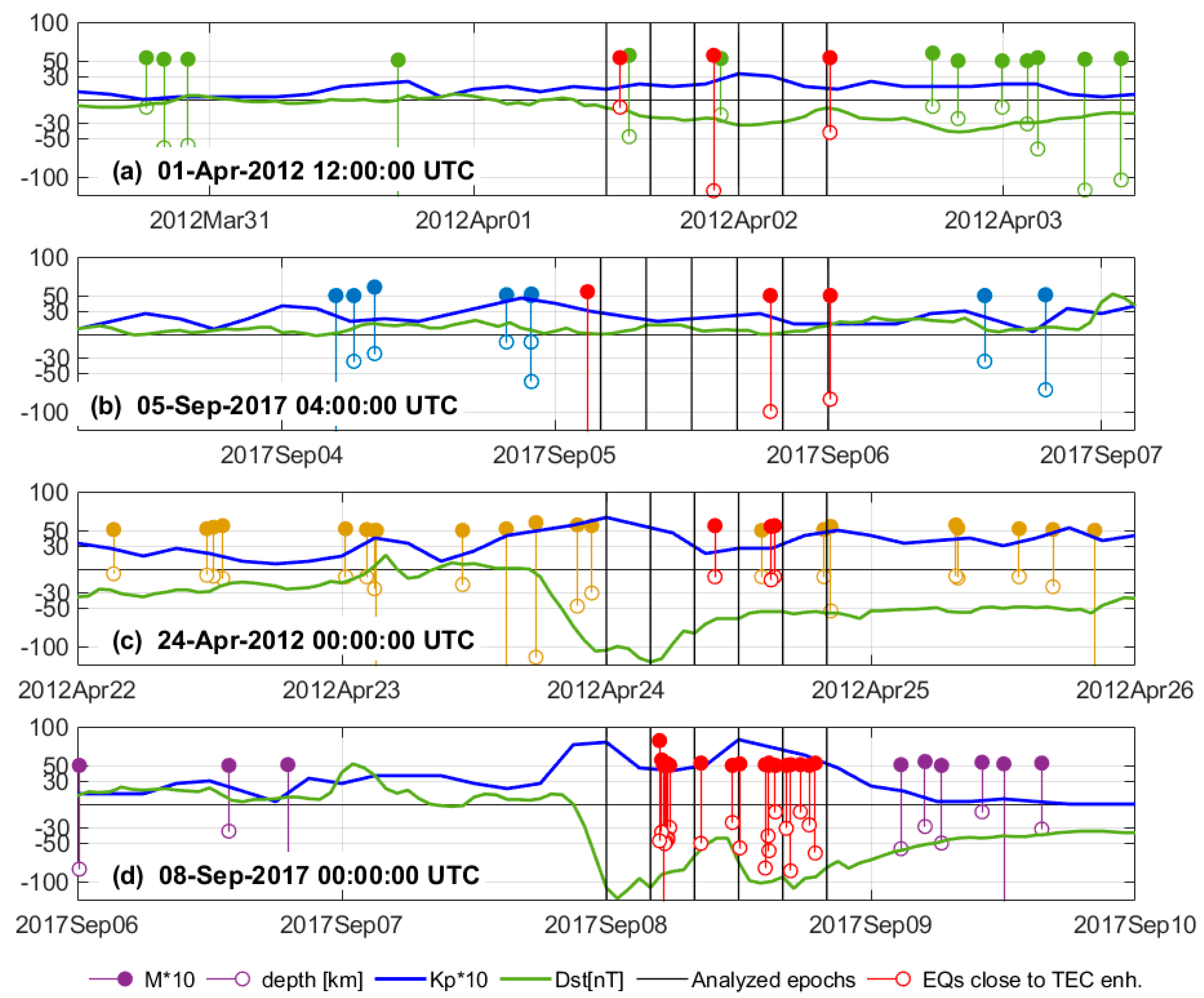
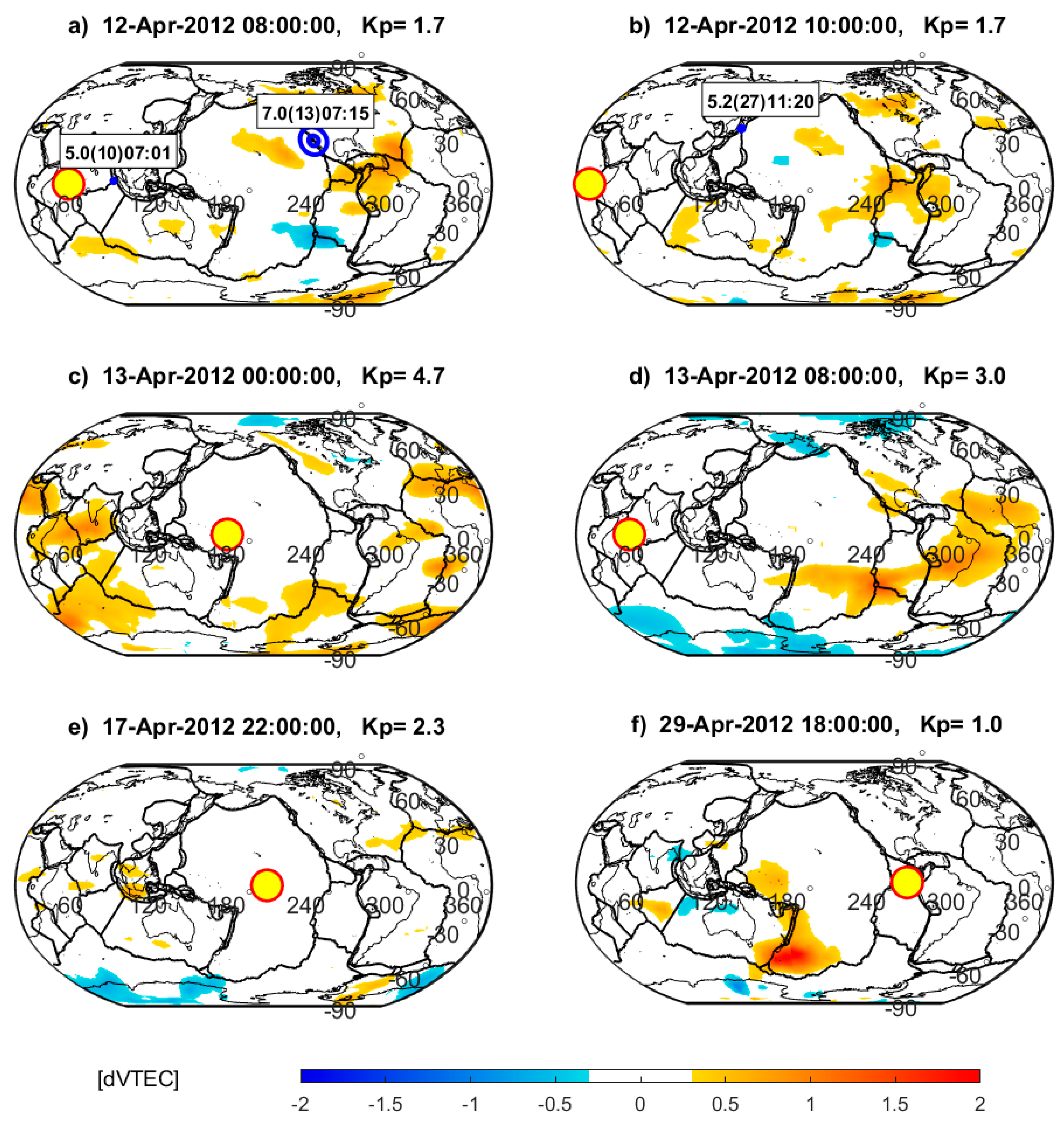
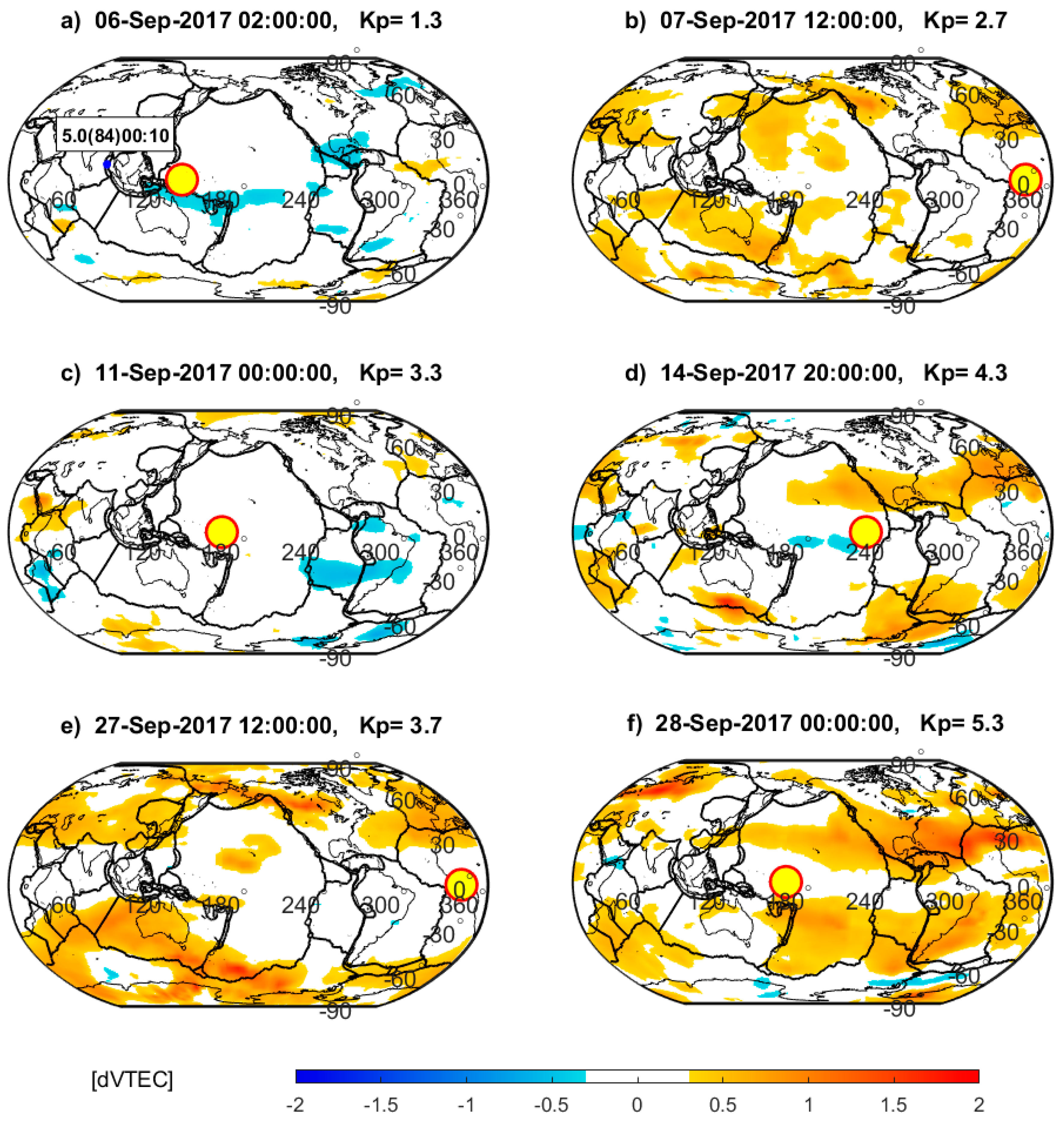
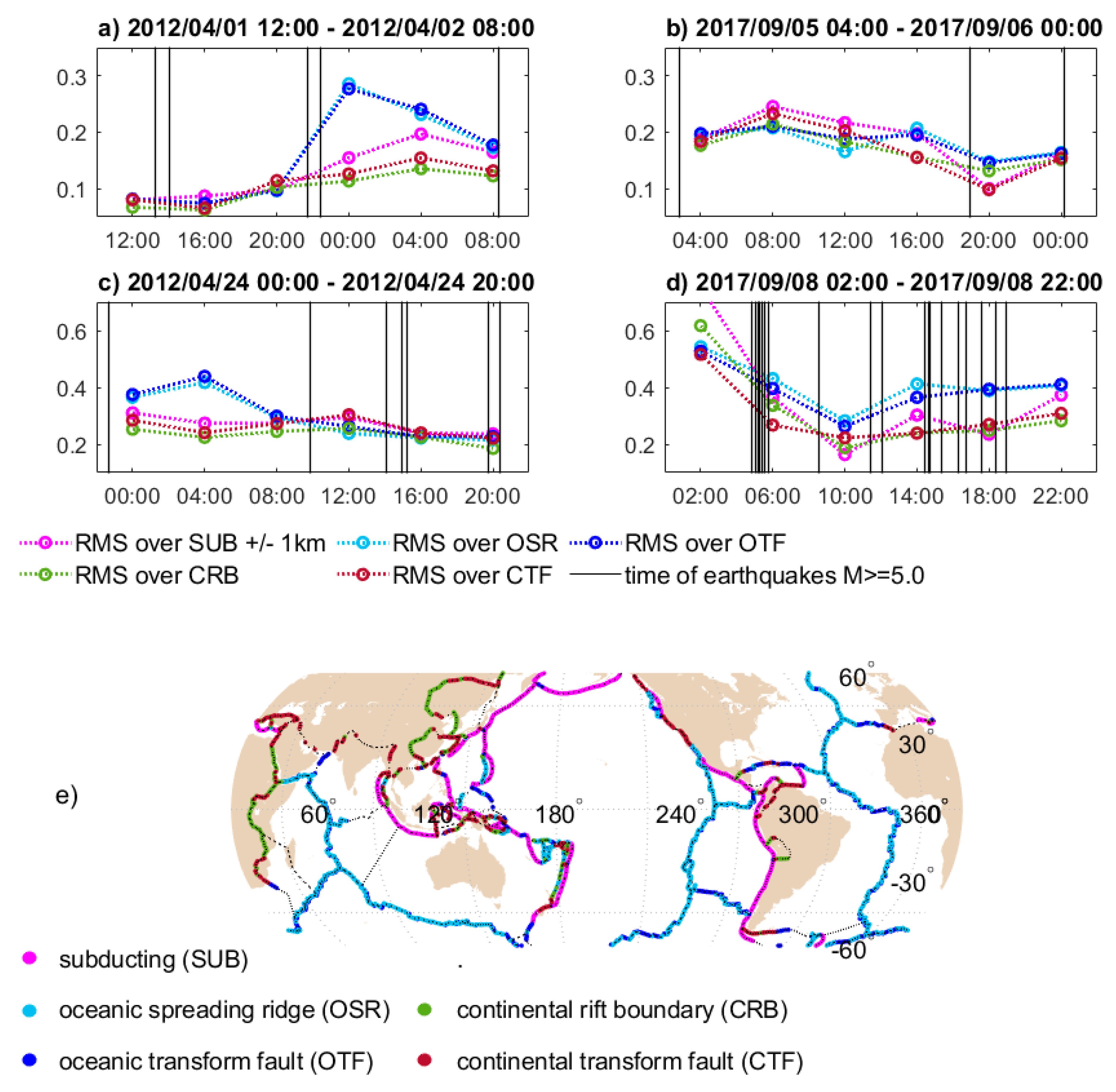
Disclaimer/Publisher’s Note: The statements, opinions and data contained in all publications are solely those of the individual author(s) and contributor(s) and not of MDPI and/or the editor(s). MDPI and/or the editor(s) disclaim responsibility for any injury to people or property resulting from any ideas, methods, instructions or products referred to in the content. |
© 2025 by the authors. Licensee MDPI, Basel, Switzerland. This article is an open access article distributed under the terms and conditions of the Creative Commons Attribution (CC BY) license (https://creativecommons.org/licenses/by/4.0/).
Share and Cite
Wielgosz, P.; Jarmołowski, W.; Mazur, S.; Milanowska, B.; Krypiak-Gregorczyk, A. Vertical Total Electron Content Enhancements and Their Global Distribution in Relation to Tectonic Plate Boundaries. Remote Sens. 2025, 17, 614. https://doi.org/10.3390/rs17040614
Wielgosz P, Jarmołowski W, Mazur S, Milanowska B, Krypiak-Gregorczyk A. Vertical Total Electron Content Enhancements and Their Global Distribution in Relation to Tectonic Plate Boundaries. Remote Sensing. 2025; 17(4):614. https://doi.org/10.3390/rs17040614
Chicago/Turabian StyleWielgosz, Paweł, Wojciech Jarmołowski, Stanisław Mazur, Beata Milanowska, and Anna Krypiak-Gregorczyk. 2025. "Vertical Total Electron Content Enhancements and Their Global Distribution in Relation to Tectonic Plate Boundaries" Remote Sensing 17, no. 4: 614. https://doi.org/10.3390/rs17040614
APA StyleWielgosz, P., Jarmołowski, W., Mazur, S., Milanowska, B., & Krypiak-Gregorczyk, A. (2025). Vertical Total Electron Content Enhancements and Their Global Distribution in Relation to Tectonic Plate Boundaries. Remote Sensing, 17(4), 614. https://doi.org/10.3390/rs17040614










